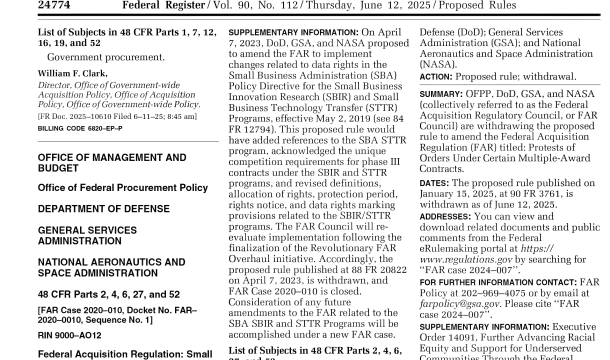Taking A Closer Look At The House’s 2018 NDAA Bill
Earlier this month, the House passed its bill authorizing $696 billion in Department of Defense (DoD) spending for the 2018 fiscal year. The Senate Armed Services Committee recently completed markup of the Senate’s version of NDAA 2018, and now that healthcare legislation is off the calendar, the Senate should begin consideration of its bill shortly.
Getting back to the bill that passed the House, though, certain aspects of the authorization have already attracted significant attention, including a proposed establishment of a Space Corps, which would be a distinct military service within the U.S. Air Force. Other noted aspects of the bill include provisions that prevent a new round of base realignment and closures, that reauthorize the Women’s Business Center program, that provide significant resources to hiring and training acquisition personnel on acquisition of commercial items, and that establish a program for acquiring commercial products from “online marketplaces” widely used in the private sector. Whether these or other House provisions survive after a Senate bill is passed and conflicts worked out remains to be seen.
Nevertheless, for DoD contractors, the House bill certainly reflects the priorities of agency and industry constituencies vocal enough to have their spending priorities expressed in the proposed legislation. Indeed, to the extent the House bill represents a wishlist of defense spending, it may offer a glimpse, albeit hazy and imperfect, of potential opportunities that may someday materialize in future DoD solicitations and Broad Agency Announcements. Consequently, even at this stage contractors - particularly technology innovators and small business subcontractors - wishing to make predictions on which way DoD budgetary winds will blow may want to take a close look at the House bill.
The bill, for example, includes authorizations for typical expenditures such as aircraft, submarine and destroyer acquisitions. Of greater interest to construction contractors and subcontractors, perhaps, the House bill also includes authorizations for approximately $10 billion in military construction projects, land acquisition, and family housing projects for the Army, Navy, Air Force, National Guard and Reserve, and defense agencies.
The bill also points to new and intriguing defense systems that may drive future technological innovation. For example, in addition to authorizing expenditures for ground-based missile defense systems, the House bill also authorizes DoD to develop a space-based “sensor layer” for detection and tracking of ballistic and hypersonic missiles, as well as a space-based “intercept layer” for targeting and intercept of ballistic missiles. And an interesting, if not sobering, glimpse of the kinds of threats DoD may arm against in the future is offered in provisions that established the “Commission to Assess the Threat to the United States from Electromagnetic Pulse Attacks and Events,” which is supposed to assess and make recommendations with respect to the threat to the U.S. from electromagnetic pulse attacks and events. In connection with the establishment of the space-based missile programs and the electromagnetic pulse attack commission, the bill requires DoD agencies to examine and report on both mature technologies and technologies requiring further research and development, as well as the feasibility and cost of solutions. Consequently, any public reports that come out of these programs should be of interest to companies pursuing emerging technologies.
To view or download the House's version of 2018 NDAA, go here.
To read other articles from The GovCon Bulletin™ go here.



